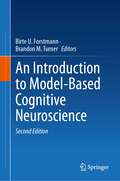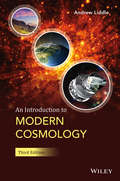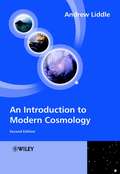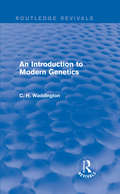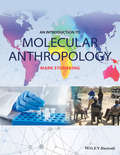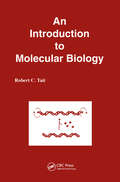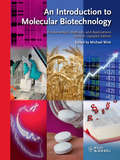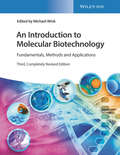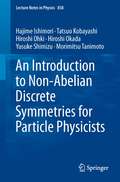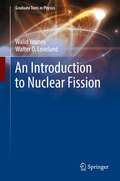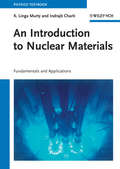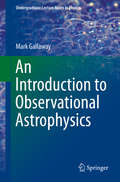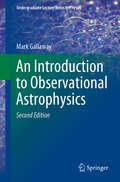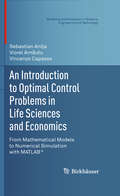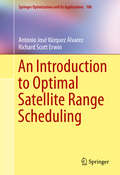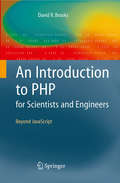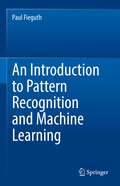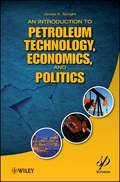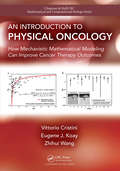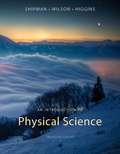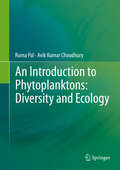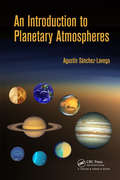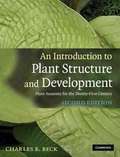- Table View
- List View
An Introduction to Model-Based Cognitive Neuroscience
by Birte U. Forstmann Brandon M. TurnerThe main goal of this edited collection is to promote the integration of cognitive modeling and cognitive neuroscience. Experts in the field provide tutorial-style chapters that explain particular techniques and highlight their usefulness through concrete examples and numerous case studies. The book also includes a thorough list of references pointing the reader toward additional literature and online resources. The second edition of Introduction to Model-Based Cognitive Neuroscience explores important new advances in the field including joint modeling and applications in areas such as computational psychiatry, neurodegenerative diseases, and social decision-making.
An Introduction to Modern Cosmology
by Andrew LiddleA concise, accessible introduction to this exciting and dynamic subject.* Adopts an approach grounded in physics rather than mathematics.* Includes worked examples and student problems, along with hints for solving them and the numerical answers.* Many reviewers have commented that this is one of the best 'introductory undergraduate level' texts on the subject and they would all welcome a Second Edition.
An Introduction to Modern Cosmology
by Andrew LiddleAn Introduction to Modern Cosmology Third Edition is an accessible account of modern cosmological ideas. The Big Bang Cosmology is explored, looking at its observational successes in explaining the expansion of the Universe, the existence and properties of the cosmic microwave background, and the origin of light elements in the universe. Properties of the very early Universe are also covered, including the motivation for a rapid period of expansion known as cosmological inflation. The third edition brings this established undergraduate textbook up-to-date with the rapidly evolving observational situation. This fully revised edition of a bestseller takes an approach which is grounded in physics with a logical flow of chapters leading the reader from basic ideas of the expansion described by the Friedman equations to some of the more advanced ideas about the early universe. It also incorporates up-to-date results from the Planck mission, which imaged the anisotropies of the Cosmic Microwave Background radiation over the whole sky. The Advanced Topic sections present subjects with more detailed mathematical approaches to give greater depth to discussions. Student problems with hints for solving them and numerical answers are embedded in the chapters to facilitate the reader’s understanding and learning. Cosmology is now part of the core in many degree programs. This current, clear and concise introductory text is relevant to a wide range of astronomy programs worldwide and is essential reading for undergraduates and Masters students, as well as anyone starting research in cosmology.
An Introduction to Modern Genetics (Routledge Revivals: Selected Works of C. H. Waddington)
by C. H. WaddingtonFirst published in 1939 (second impression in 1950), this book provides an account of the changes in, and main principles of, genetics at that time. These are illustrated by references to the most authoritative and then recent investigations. Special attention is paid to the way in which genetics overlaps with other fields of inquiry, since it is often in these border-line subjects that the most important advances are to be expected. The book is particularly arranged to suit the convenience of students whose previous knowledge of genetics is small, and contains annotated bibliographies of suggestions for further reading.
An Introduction to Molecular Anthropology
by Mark StonekingMolecular anthropology uses molecular genetic methods to address questions and issues of anthropological interest. More specifically, molecular anthropology is concerned with genetic evidence concerning human origins, migrations, and population relationships, including related topics such as the role of recent natural selection in human population differentiation, or the impact of particular social systems on patterns of human genetic variation. Organized into three major sections, An Introduction to Molecular Anthropology first covers the basics of genetics - what genes are, what they do, and how they do it - as well as how genes behave in populations and how evolution influences them. The following section provides an overview of the different kinds of genetic variation in humans, and how this variation is analyzed and used to make evolutionary inferences. The third section concludes with a presentation of the current state of genetic evidence for human origins, the spread of humans around the world, the role of selection and adaptation in human evolution, and the impact of culture on human genetic variation. A final, concluding chapter discusses various aspects of molecular anthropology in the genomics era, including personal ancestry testing and personal genomics. An Introduction to Molecular Anthropology is an invaluable resource for students studying human evolution, biological anthropology, or molecular anthropology, as well as a reference for anthropologists and anyone else interested in the genetic history of humans.
An Introduction to Molecular Biology
by 0 R.C. Tait,This book explains molecular biology concepts clearly and in practical terms. It represents an invaluable introduction to molecular biology for undergraduates, postgraduates, researchers, lecturers, medics, nurses, teachers, scientists, editors, and all t
An Introduction to Molecular Biotechnology: Fundamentals, Methods and Applications
by Michael WinkMolecular biotechnology continues to triumph, as this textbook testifies - edited by one of the academic pioneers in the field and written by experienced professionals. This completely revised second edition covers the entire spectrum, from the fundamentals of molecular and cell biology, via an overview of standard methods and technologies, the application of the various "-omics", and the development of novel drug targets, right up to the significance of system biology in biotechnology. The whole is rounded off by an introduction to industrial biotechnology as well as chapters on company foundation, patent law and marketing. The new edition features: - Large format and full color throughout - Proven structure according to basics, methods, main topics and economic perspectives - New sections on system biology, RNA interference, microscopic techniques, high throughput sequencing, laser applications, biocatalysis, current biomedical applications and drug approval - Optimized teaching with learning targets, a glossary containing around 800 entries, over 500 important abbreviations and further reading. The only resource for those who are seriously interested in the topic. Bonus material available online free of charge: www.wiley-vch.de/home/molecbiotech
An Introduction to Molecular Biotechnology: Fundamentals, Methods and Applications
by Michael WinkCompletely updated in line with the rapid progress made in the field, this new edition of the highly-praised textbook addresses powerful new methods and concepts in biotechnology, such as genome editing, reprogrammed stem cells, and personalized medicine. An introduction to the fundamentals in molecular and cell biology is followed by a description of standard techniques, including purification and analysis of biomolecules, cloning techniques, gene expression systems, genome editing methods, labeling of proteins and in situ-techniques, standard and high resolution microscopy. The third part focuses on key areas in research and application, ranging from functional genomics, proteomics and bioinformatics to drug targeting, recombinant antibodies and systems biology. The final part looks at the biotechnology industry, explaining intellectual property issues, legal frameworks for pharmaceutical products and the interplay between start-up and larger companies. The contents are beautifully illustrated throughout, with hundreds of full color diagrams and photographs. Provides students and professionals in life sciences, pharmacy and biochemistry with everything they need to know about molecular biotechnology.
An Introduction to Non-Abelian Discrete Symmetries for Particle Physicists (Lecture Notes in Physics #858)
by Morimitsu Tanimoto Hiroshi Ohki Hiroshi Okada Yusuke Shimizu Hajime Ishimori Tatsuo KobayashiThese lecture notes provide a tutorial review of non-Abelian discrete groups and show some applications to issues in physics where discrete symmetries constitute an important principle for model building in particle physics. While Abelian discrete symmetries are often imposed in order to control couplings for particle physics - in particular model building beyond the standard model - non-Abelian discrete symmetries have been applied to understand the three-generation flavor structure in particular. Indeed, non-Abelian discrete symmetries are considered to be the most attractive choice for the flavor sector: model builders have tried to derive experimental values of quark and lepton masses, and mixing angles by assuming non-Abelian discrete flavor symmetries of quarks and leptons, yet, lepton mixing has already been intensively discussed in this context, as well. The possible origins of the non-Abelian discrete symmetry for flavors is another topic of interest, as they can arise from an underlying theory - e.g. the string theory or compactification via orbifolding - thereby providing a possible bridge between the underlying theory and the corresponding low-energy sector of particle physics. This text explicitly introduces and studies the group-theoretical aspects of many concrete groups and shows how to derive conjugacy classes, characters, representations, and tensor products for these groups (with a finite number) when algebraic relations are given, thereby enabling readers to apply this to other groups of interest.
An Introduction to Nuclear Fission (Graduate Texts in Physics)
by Walter D. Loveland Walid YounesThis hands-on textbook introduces physics and nuclear engineering students to the experimental and theoretical aspects of fission physics for research and applications through worked examples and problem sets. The study of nuclear fission is currently undergoing a renaissance. Recent advances in the field create the opportunity to develop more reliable models of fission predictability and to supply measurements and data to critical applications including nuclear energy, national security and counter-proliferation, and medical isotope production. An Introduction to Nuclear Fission provides foundational knowledge for the next generation of researchers to contribute to nuclear fission physics.
An Introduction to Nuclear Materials
by Indrajit Charit K. Linga MurtyCovering both fundamental and advanced aspects in an accessible way, this textbook begins with an overview of nuclear reactor systems, helping readers to familiarize themselves with the varied designs. Then the readers are introduced to different possibilities for materials applications in the various sections of nuclear energy systems. Materials selection and life prediction methodologies for nuclear reactors are also presented in relation to creep, corrosion and other degradation mechanisms. An appendix compiles useful property data relevant for nuclear reactor applications.Throughout the book, there is a thorough coverage of various materials science principles, such as physical and mechanical metallurgy, defects and diffusion and radiation effects on materials, with serious efforts made to establish structure-property correlations wherever possible. With its emphasis on the latest developments and outstanding problems in the field, this is both a valuable introduction and a ready reference for beginners and experienced practitioners alike.
An Introduction to Nuclear Physics
by W. N. Cottingham D. A. GreenwoodThis introduction to nuclear physics provides an excellent basis for a core undergraduate course in this area. The authors show how simple models can provide an understanding of the properties of nuclei, both in their ground and excited states, and of the nature of nuclear reactions. They include chapters on nuclear fission, its application in nuclear power reactors, the role of nuclear physics in energy production and nucleosynthesis in stars. This new edition contains several additional topics: muon-catalyzed fusion, the nuclear and neutrino physics of supernovae, neutrino mass and neutrino oscillations, and the biological effects of radiation. A knowledge of basic quantum mechanics and special relativity is assumed. Each chapter ends with a set of problems accompanied by outline solutions.
An Introduction to Observational Astrophysics (Undergraduate Lecture Notes in Physics)
by Mark GallawayObservational Astrophysics follows the general outline of an astrophysics undergraduate curriculum targeting practical observing information to what will be covered at the university level. This includes the basics of optics and coordinate systems to the technical details of CCD imaging, photometry, spectography and radio astronomy. General enough to be used by students at a variety of institutions and advanced enough to be far more useful than observing guides targeted at amateurs, the author provides a comprehensive and up-to-date treatment of observational astrophysics at undergraduate level to be used with a university's teaching telescope. The practical approach takes the reader from basic first year techniques to those required for a final year project. Using this textbook as a resource, students can easily become conversant in the practical aspects of astrophysics in the field as opposed to the classroom.
An Introduction to Observational Astrophysics (Undergraduate Lecture Notes in Physics)
by Mark GallawayThe observational component of astronomy is an exciting and vital part of any astrophysics degree. With the advent of low-cost astronomical cameras and remote and robotic operation, more students than ever have the opportunity to observe and perform observatory research. This updated and fully corrected textbook provides a comprehensive overview of practical observing techniques for undergraduate astrophysics courses. The chapters introduce students to the basics of the field before delving into telescope types, the nature and operation of the astronomical camera, imaging techniques and reduction, photometry and spectrography, and solar and radio observations.The second edition covers the latest research on calibrating the telescope-camera-observatory system. It contains revised information on all available astronomy equipment, including filters, webcams, sensors, and telescope designs. Also included is an entirely new chapter on exoplanet transit measurements. The textbook’s practical approach will guide readers from basic first-year techniques to those required for a final-year project.
An Introduction to Optimal Control Problems in Life Sciences and Economics: From Mathematical Models to Numerical Simulation with MATLAB® (Modeling and Simulation in Science, Engineering and Technology)
by Viorel Arnăutu Sebastian Aniţa Vincenzo CapassoCombining control theory and modeling, this textbook introduces and builds on methods for simulating and tackling concrete problems in a variety of applied sciences. Emphasizing "learning by doing," the authors focus on examples and applications to real-world problems. An elementary presentation of advanced concepts, proofs to introduce new ideas, and carefully presented MATLAB® programs help foster an understanding of the basics, but also lead the way to new, independent research. With minimal prerequisites and exercises in each chapter, this work serves as an excellent textbook and reference for graduate and advanced undergraduate students, researchers, and practitioners in mathematics, physics, engineering, computer science, as well as biology, biotechnology, economics, and finance.
An Introduction to Optimal Satellite Range Scheduling (Springer Optimization and Its Applications #106)
by Antonio José Vázquez Álvarez Richard Scott ErwinThe satellite range scheduling (SRS) problem, an important operations research problem in the aerospace industry consisting of allocating tasks among satellites and Earth-bound objects, is examined in this book. SRS principles and solutions are applicable to many areas, including: Satellite communications, where tasks are communication intervals between sets of satellites and ground stations Earth observation, where tasks are observations of spots on the Earth by satellites Sensor scheduling, where tasks are observations of satellites by sensors on the Earth. This self-contained monograph begins with a structured compendium of the problem and moves on to explain the optimal approach to the solution, which includes aspects from graph theory, set theory, game theory and belief networks. This book is accessible to students, professionals and researchers in a variety of fields, including: operations research, optimization, scheduling theory, dynamic programming and game theory. Taking account of the distributed, stochastic and dynamic variants of the problem, this book presents the optimal solution to the fixed interval SRS problem and how to migrate results into more complex cases. Reference algorithms and traditional algorithms for solving the scheduling problems are provided and compared with examples and simulations in practical scenarios.
An Introduction to PHP for Scientists and Engineers: Beyond JavaScript
by David R. BrooksThis book provides an introduction to PHP and server-side programming. It presents readers with a science or engineering background with the information to write their own online applications requiring reading, creating and manipulating data files stored as text on a server, overcoming the limitations of a client-side language. It focuses only on those elements of the language, such as file input/output, arrays, built-in math functions, and user-created functions that are essential for solving a wide range of scientific/engineering computing problems - and assumes a working knowledge of programming concepts and HTML, JavaScript, C or a similar language. It contains complete applications and hence offers a very compact and efficient way for working professionals to take advantage of the possibilities offered by server-side programming. Written for a technical audience, this book is an effective learning tool to the essentials of PHP and is also ideal for self-study.
An Introduction to Pattern Recognition and Machine Learning
by Paul FieguthThe domains of Pattern Recognition and Machine Learning have experienced exceptional interest and growth, however the overwhelming number of methods and applications can make the fields seem bewildering. This text offers an accessible and conceptually rich introduction, a solid mathematical development emphasizing simplicity and intuition. Students beginning to explore pattern recognition do not need a suite of mathematically advanced methods or complicated computational libraries to understand and appreciate pattern recognition; rather the fundamental concepts and insights, eminently teachable at the undergraduate level, motivate this text. This book provides methods of analysis that the reader can realistically undertake on their own, supported by real-world examples, case-studies, and worked numerical / computational studies.
An Introduction to Petroleum Technology, Economics, and Politics
by James G. SpeightThe perfect primer for both the layperson and the engineer, for the new hire and the old hand, describing, in easy-to-understand language, one of the biggest and most lucrative industries in the world. There is only one substance known to mankind that can cause wars, influence global economies, and make entire countries rich: petroleum. One teaspoon of the stuff carries enough energy to power a ton truck up a hill. It's in the news every single day, it influences our lives in ways that we cannot fathom, and it is the most important commodity in the world. But how much does the average person, even the average engineer, know about it? This book describes the petroleum industry, in easy-to-understand language, for both the layperson and engineer alike. From the economics of searching for oil and gas to the pitfalls of drilling and production, getting it out of the ground, into pipelines, into refineries, and, finally, into your gas tank, this book covers the petroleum industry like no other treatment before. There is coverage of pricing and the economics of this very important resource, as well, which is useful not only to engineers, but to economists and, really, anyone who uses it. From jet fuel to gasoline to natural gas and plastics, petroleum is one of the integral products of our lives. We are practically bathed it in from birth, our food is protected by it, and it even has healing properties. Learn all about this incredible substance and its fascinating history and highly debated future. An Introduction to Petroleum Technology, Economics, and Politics: Gives a thorough summary of the petroleum and natural gas industry, from prospect to production to pipeline New technologies, such as directional and underbalanced drilling, are covered, in easy-to-understand language Useful not only for newcomers and laypersons, but for engineers and students, particularly those for whom English is a second language Examines the basics of pricing and valuation
An Introduction to Physical Oncology: How Mechanistic Mathematical Modeling Can Improve Cancer Therapy Outcomes (Chapman & Hall/CRC Mathematical Biology Series)
by Vittorio Cristini Eugene Koay Zhihui WangPhysical oncology has the potential to revolutionize cancer research and treatment. The fundamental rationale behind this approach is that physical processes, such as transport mechanisms for drug molecules within tissue and forces exchanged by cancer cells with tissue, may play an equally important role as biological processes in influencing progression and treatment outcome. <P><P>This book introduces the emerging field of physical oncology to a general audience, with a focus on recent breakthroughs that help in the design and discovery of more effective cancer treatments. It describes how novel mathematical models of physical transport processes incorporate patient tissue and imaging data routinely produced in the clinic to predict the efficacy of many cancer treatment approaches, including chemotherapy and radiation therapy. By helping to identify which therapies would be most beneficial for an individual patient, and quantifying their effects prior to actual implementation in the clinic, physical oncology allows doctors to design treatment regimens customized to each patient’s clinical needs, significantly altering the current clinical approach to cancer treatment and improving the outcomes for patients.
An Introduction to Physical Science (13th Edition)
by James Shipman Jerry D. Wilson Aaron Todd Charles A. HigginsConsistent with previous editions of An Introduction to Physical Science, the goal of the new Thirteenth edition is to stimulate students' interest in and gain knowledge of the physical sciences. Presenting content in such a way that students develop the critical reasoning and problem-solving skills that are needed in an ever-changing technological world, the authors emphasize fundamental concepts as they progress through the five divisions of physical sciences: physics, chemistry, astronomy, meteorology, and geology. Ideal for a non-science majors course, topics are treated both descriptively and quantitatively, providing instructors the flexibility to emphasize an approach that works best for their students.
An Introduction to Phytoplanktons: Diversity And Ecology
by Ruma Pal Avik Kumar ChoudhuryThe book , 'An Introduction to Phytoplanktons - Diversity and Ecology' is very useful as it covers wide aspects of phytoplankton study including the general idea about cyanobacteria and algal kingdom. It contains different topics related to very basic idea of phytoplanktons such as, types ,taxonomic description and the key for identification etc. Together with it, very modern aspects of phytoplankton study including different methodologies needed for research students of botany, ecology, limnology and environmental biology are also included. The first chapter is very basic and informative and describes algal and phytoplankton classification, algal pigments, algal bloom and their control, algal toxins, wetlands algae, ecological significance of phytoplanktons etc. A general key for identification of common phytoplankton genera is also included for students who will be able to identify these genera based on the light microscopic characters. In Chapters 2-4, different aspects of phytoplankton research like primary productivity, community pattern analysis and their ecological parameter analysis have been discussed with detailed procedures. Statistical analysis is also discussed in detail. Chapter 5 includes case studies related to review, phytoplankton diversity and dynamics.
An Introduction to Planetary Atmospheres
by Agustin Sanchez-LavegaPlanetary atmospheres is a relatively new, interdisciplinary subject that incorporates various areas of the physical and chemical sciences, including geophysics, geophysical fluid dynamics, atmospheric science, astronomy, and astrophysics. Providing a much-needed resource for this cross-disciplinary field, An Introduction to Planetary Atmospheres p
An Introduction to Plant Structure and Development
by Charles B. BeckA plant anatomy textbook unlike any other on the market today. Carol A. Peterson described the first edition as 'the best book on the subject of plant anatomy since the texts of Esau'. Traditional plant anatomy texts include primarily descriptive aspects of structure, this book not only provides a comprehensive coverage of plant structure, but also introduces aspects of the mechanisms of development, especially the genetic and hormonal controls, and the roles of plasmodesmata and the cytoskeleton. The evolution of plant structure and the relationship between structure and function are also discussed throughout. Includes extensive bibliographies at the end of each chapter. It provides students with an introduction to many of the exciting, contemporary areas at the forefront of research in the development of plant structure and prepares them for future roles in teaching and research in plant anatomy.
An Introduction to Polysaccharide Biotechnology
by Stephen E. Harding Michael P. Tombs Gary G. Adams Berit Smestad Paulsen Kari Tvete Inngjerdingen Hilde BarsettPolysaccharides and related high molecular weight glycans are hugely diverse with wide application in Biotechnology and great opportunities for further exploitation. An Introduction to Polysaccharide Biotechnology – a second edition of the popular original text by Tombs and Harding – introduces students, researchers, clinicians and industrialists to the properties of some of the key materials involved, how these are applied, some of the economic factors concerning their production and how they are characterized for regulatory purposes.
